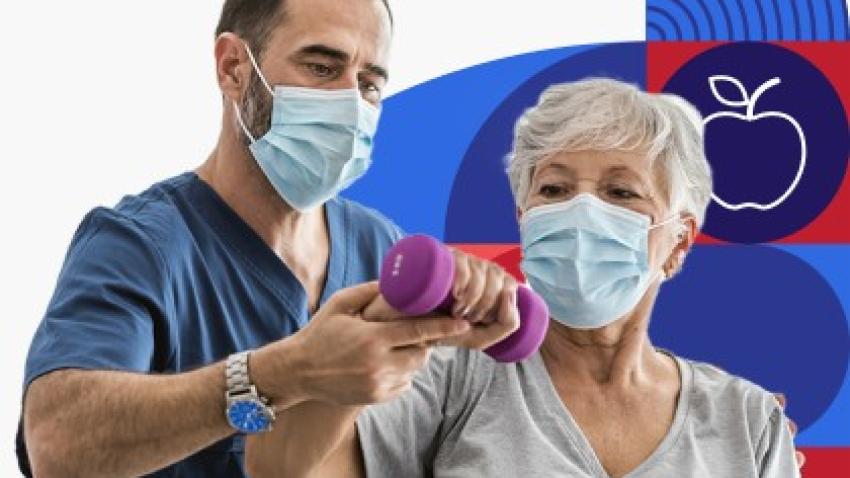

A bone density test measures how strong your bones are. The test will tell you if you have osteoporosis (weak bones), and it can help you understand your risk of breaking a bone in the future.
Women are at higher risk for osteoporosis than men, and the risk goes up with age.
Men can get osteoporosis, too. If you’re a man over age 65 years and you’re concerned about your bone strength, talk with your doctor or nurse.
Osteoporosis is a bone disease. It means your bones are weak and more likely to break. People with osteoporosis most often break bones in the hip, spine, and wrist.
There are no signs or symptoms of osteoporosis. You might not know you have the disease until you break a bone. That’s why it’s so important to get a bone density test to measure your bone strength.
A bone density test is like an x-ray or scan of your body. The test doesn’t hurt, and you don't need to do anything to prepare for it. It usually takes less than 15 minutes.
Osteoporosis is most common in older women, but men can also get it. Your risk for osteoporosis goes up as you get older.
Other things can raise your risk for osteoporosis, including:
If you have osteoporosis, you can still slow down bone loss. Finding and treating the disease early can keep you healthier and more active — and help lower your risk of breaking bones.
Depending on the results of your bone density test, you may need to:
Talk with your doctor about what steps are right for you. No matter how old you are, it’s never too late to improve your bone health.
Take these steps to protect your bone health.
Ask your doctor if you’re at risk for osteoporosis and if you need to schedule a bone density test.
Use these questions about osteoporosis to start a conversation with your doctor at your next checkup.
Under the Affordable Care Act, insurance plans must cover screening for osteoporosis for:
Depending on your insurance plan, you may be able to get screened at no cost to you. Check with your insurance company to find out more.
Medicare may also cover bone density tests at no cost. If you have Medicare, learn about Medicare coverage for bone density tests .
If you don’t have insurance, you may still be able to get a free or low-cost bone density test. Find a health center near you and ask about bone density tests .
To learn more, check out these resources:
You need both calcium and vitamin D for strong bones.
Calcium helps keep your bones strong. You can get calcium from:
Vitamin D helps your body take in calcium.
Your body makes vitamin D when you’re out in the sun. You can also get vitamin D from:
Physical activity can help slow down bone loss. Do muscle-strengthening activities (like lifting weights or using resistance bands) and weight-bearing activities (like brisk walking or doing jumping jacks) to strengthen your bones. And do balance activities (like tai chi or carefully walking backward) to help prevent falls.
Try these tips to get active:
Find out more about how to stay active to take care of your bones:
You don't need special equipment or a gym membership to stay active. Check with your local community center or senior center to find fun, affordable ways to get active.
If you have a health condition or a disability, be as active as you can. If you’re unsure what activities are right for you, consider talking with your doctor or nurse.
For more tips on staying active, check out these resources:
Smoking cigarettes and drinking too much alcohol can make you more likely to get osteoporosis.
Falls can be especially serious for people with weak bones. You can make small changes to lower your risk of falling, like doing exercises that improve your balance. You can also take steps to make your home safer, like installing railings on both sides of your stairs.
Content last updated April 8, 2024
This information on bone density and osteoporosis was adapted from materials from the National Institute of Arthritis and Musculoskeletal and Skin Diseases (NIAMS).
Reviewed by:
Leslie Rivera Quiroz, M. A.
Communications Specialist
Science Communications and Outreach Branch
National Institute of Arthritis and Musculoskeletal and Skin Diseases
National Institutes of Health
Trish Reynolds, RN, MS
Writer-Editor/Media Liaison
Science Communications and Outreach Branch
National Institute of Arthritis and Musculoskeletal and Skin Diseases
National Institutes of Health



This microsite is coordinated by the Office of Disease Prevention and Health Promotion, Office of the Assistant Secretary for Health, Office of the Secretary, U.S. Department of Health and Human Services.
Last updated: September 5, 2024
Linking to a non-federal website does not constitute an endorsement by ODPHP or any of its employees of the sponsors or the information and products presented on the website.
You will be subject to the destination website's privacy policy when you follow the link.
HHS is not responsible for Section 508 compliance (accessibility) on other federal or private websites.